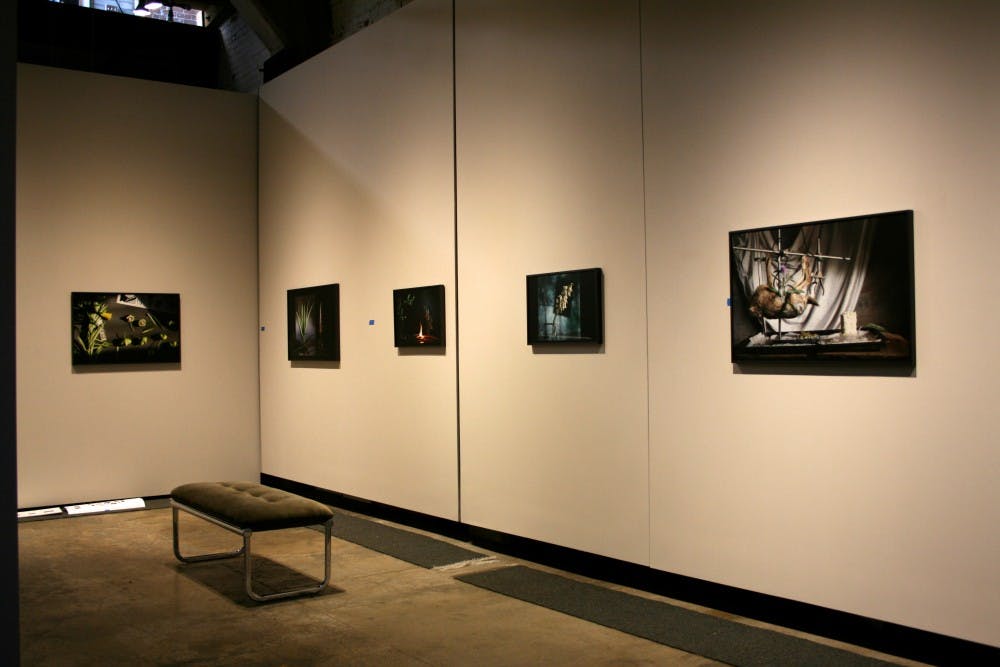One photography student is using his thesis exhibition, "Vivarium," to explore parts of nature humans typically step on and over on a daily basis, and gives them the fine art treatment he feels they deserve.
Photography MFA student Ryan Parra said vivarium is the Latin word meaning "place of life," a concept that beautifully encapsulated his purpose behind the show's detailed presentation of plants and their critical place in our world.
"I enjoy plants, and I think they’re important," Parra said. "I think our lifestyle these days; we’re quite disengaged with nature; we’re quite separate from plants. I definitely want the viewer to think about the plants that maybe are thought of as just weeds in their backyard, or plants along the roadside on your way to work that all get ignored."
Some of the plants he showcased in his immaculately lit and posed still life photos were those he discovered figuratively and then literally grew in his own backyard. His current favorite photo, for instance, highlights many layers and angles of a psychoactive plant that bore a striking resemblance to one in his yard.
Parra said other photos were born out of research and reading books such as "At The Desert's Green Edge," where he learned a bit about the history of the Pima tribe and its traditional uses of plants. One of his photos reflects the use of the boiled root of a certain plant as an eye wash.
Parra said his photos rarely contain only a single, simple plant — rather, he said, he uses copious research to construct an entire still life scene in which he uses miscellaneous materials, photos and artifacts to illustrate that plant's profound purpose beyond simply being a nice thing to look at or something to trim away.
He said some of his older photos took on more of an art history appearance in contrast with some of his more minimalistic recent work.
"When I started them out, I got a bunch of still life history books," he said. "I like how (my older photos) have a sense of familiarity. It made sense with focusing on traditional uses of the plants."
A perfect example of this traditional illustration is a photo that shows a dead rabbit still dusted with frost hanging by a block of cheese in front of a draping white sheet.
Parra said the seed pods in the photo could be crushed into powder, added to warm milk and mixed with a rabbit stomach to make cheese. Although Parra didn't actually perform that process, the stand-in cheese illustrates the concept.
However, not all of Parra's photos are so strikingly bold. He said he will also be displaying a collection of landscape photos he took over the past few years as he’s traveled to places like Jerome, Arizona; White Sands, New Mexico and the arches of Utah.
“Everybody goes to Utah to look at these big, amazing arches … and I’m over there taking pictures of the plants,” Parra laughed.
Parra said he completed his undergraduate degree in Oregon, where his appreciation and passion for plants and their underrated importance reached a whole new level as he recognized the community that can form around them.
Although Parra said his experience and research have led him to realize there are still many people around the world who appreciate the power of plants, he described his artistic relationship with them as more introspective and personal.
"I’ll find a plant and read a bunch of stories, and if I find interesting stuff and interesting uses, I’ll bring still lives in to inform the viewers, a bit like a painting," he said. "Other times, I like to think of it as just my interest in ... the shaman and the shamanic practice of not thinking while you’re doing, or meditatively looking. Kind of like a Jackson Pollock painting where he’s trying not to think, and he’s trying to just follow his intuitive energy. I like to do that too, just try not to think too much, although it’s hard."
Ultimately, Parra said many effects of science and scientific experiments are simply too beautifully complex and powerful to put into words.
Parra also said there is no scientific instrument to measure his experiment with dimethyltryptamine, a compound explored in one of his photos.
"Words can’t even describe it," he said. "You can’t tell somebody how amazing it was, or why it was important to you, it’s just important."
Vivarium will be on display at Northlight Gallery beginning April 15.
Related links:
Senior photography show "On The Wall" will challenge norms, provoke thought
Student creates world of her own through photography
Reach the reporter at celina.jimenez@asu.edu or follow @lina_lauren on Twitter.
Like The State Press on Facebook and follow @statepress on Twitter




